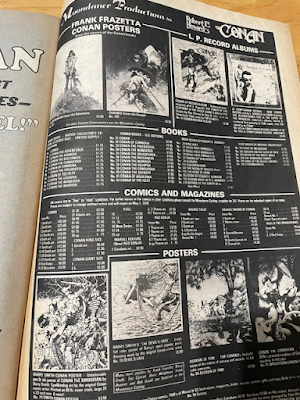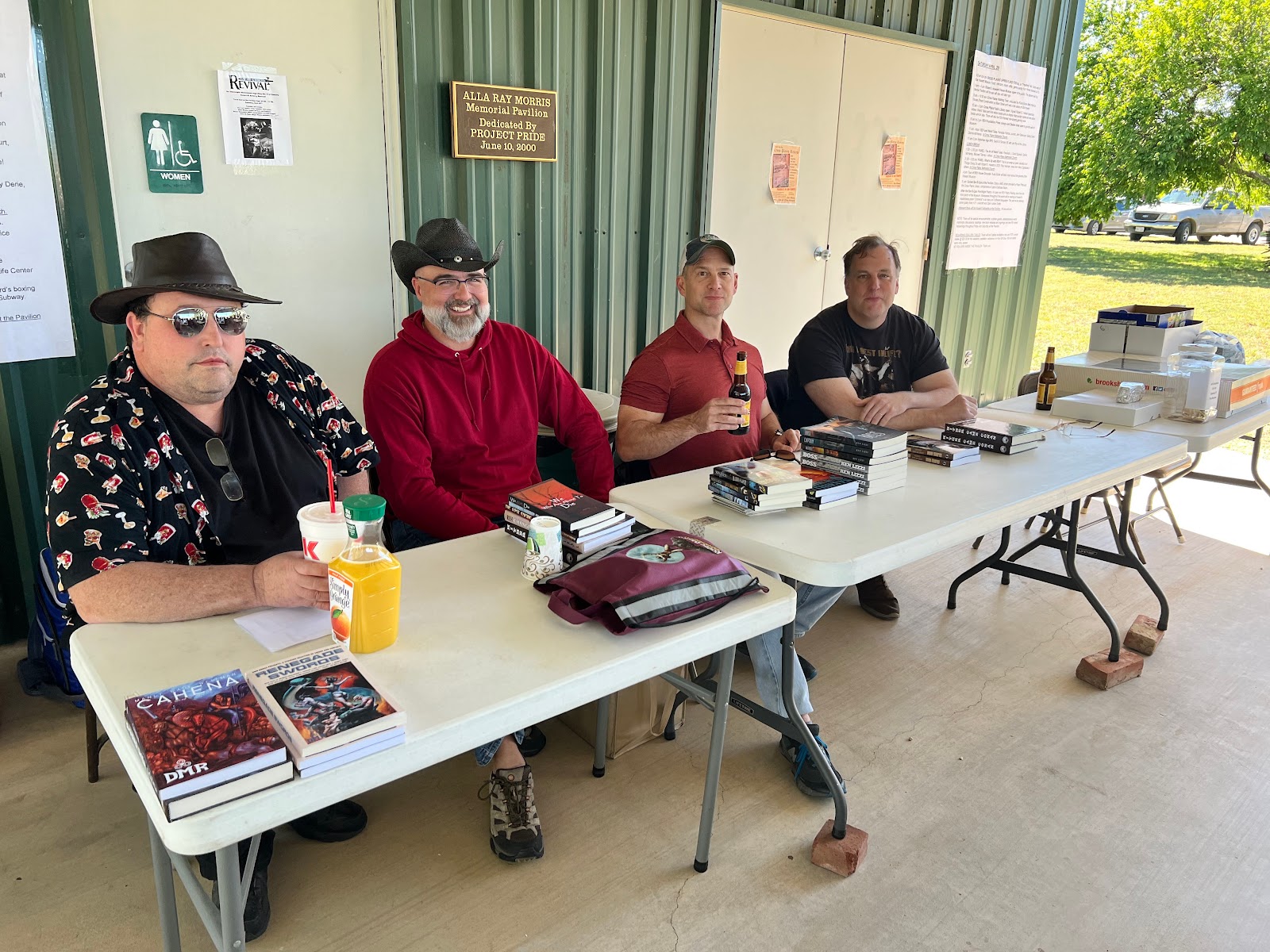 |
| These dead are unquiet... |
Nonetheless it’s how I feel.
I’m on record as loving SSOC and Roy Thomas stories and even (gasp) some of the old Lin Carter and L. Sprague de Camp Conan stories. I’m not a purist, as long as we have unadulterated Howard somewhere in print I’m good with new stories and interpretations. The Del Reys stand, so bring on the rest.
No one will ever match Howard at his own game, because he himself was of course in every story. Unless you have access via medium to his soul, or his ghost visits your shoulder like Conan did Howard and compels you to write, there will never be another REH.
While I used to indulge in Conan pastiche it’s not something I seek out anymore. I don’t read much of it these days … but once in a while I dip back in. I’ve bought the first half dozen SSOCs. I’ve read Scott Oden’s The Shadow of Vengeance and S.M. Stirling's Blood of the Serpent. I still feel a dim stir when I see the name of “Conan” in new art and stories.
What do I think makes for a good Howard pastiche? I have a few boxes I like to see checked. Here they are, and as with everything I write, YMMV.
The first and faraway most important: The story must be good, above all else. This almost covers for breaking any of the subsequent rules that follow.
The character should closely mirror the original. Conan should feel like Conan, act according to the broad parameters of his established nature. If not, why write him? That said, if a pastiche writes an immature Conan or an aged Conan reflecting on his deathbed, I would expect some new ground to be broken.
The world should feel that way too. I don’t think you should eliminate Hyborian Age countries or distort the literal map Howard laid down. The same goes for its peoples; Cimmerians should be mostly brooding and fierce, Picts savage and Pict-y. But I’m OK with adding to what is there, exploring a new island in the Vilayet or a dark and forgotten corner of Stygia, creating outlier characters and so on.
Here's what I don’t care about.
Established timelines. Because pastiche isn’t canon there is no need to connect up all the history. There is no way Conan could pack in all the adventure from every pastiche into one lifetime, so we can assume that pastiche operates independent of other pastiche—and even the originals. I don’t care how or when pastiche fits into the established storyline, even Howard’s chronology. Telling me that Conan couldn’t have done something because he was 27 at the time and a pirate might be technically accurate, but it also makes me yawn. YMMV.
Writing style. I admire when someone like Scott Oden can mirror Howard’s prose, but I don’t find it necessary. When someone covers a song I actually prefer hearing their own interpretation. Bruce Dickinson covering Sabbath Bloody Sabbath on Nativity on Black is not trying to be Ozzy … and its awesome and still honors Black Sabbath. Likewise Rob Zombie put his own unique Charles Manson inspired spin on Children of the Grave and Yungblud is fanastic covering “Changes” with his very different voice, albeit the same lyrics. Honor the original but do something new. It can sound different, whether musically or on the ear of a reader. The style should be appealing of course but it doesn’t have to sound like REH’s prose. YMMV.
***
This is a big roundabout way of saying that author John C. Hocking checks my boxes with Conan and the Living Plague, one of two complete novels published in the recent Conan: City of the Dead by Titan Books (2024).
I’m not a fan of plot summaries and I don’t feel like doing one here. But here’s what I liked about it:
Conan feels like Conan. I really like when we get to see how strong Conan is in non-combat situations. There’s a great early scene of him wielding a log-like wooden “sword” that leaves hardened mercenaries with their mouths agape; we see him lifting stone doors of crypts that baffle other strong men, on and on. Fun. But he also comports himself with the same rough barbaric code of honor, the same ferocity in battle but not recklessness, and so on.
The writing, which includes some really fine turns of phrase and metaphor. Hocking is an underrated stylist even within the small circle that is S&S but I really enjoyed passages like this:
Pezur saw Conan bare his teeth in an unconscious snarl of defiance and felt a surge of kinship with the barbarian. He knew the Cimmerian felt the rigid touch of those distant eyes as keenly as he did.
Indeed, Conan sensed the unnatural scrutiny as well as if the dim figure had reached out across Dulcine and laid a cold hand upon his breast. The undulled instincts of the barbarian sent the same thrill along his nerves that he might have felt confronting a lion in a jungle grove. Though he could not give it a name, he knew there was danger here, a danger born of black sorcery.
“What are you, devil?” growled Conan.
It’s not Howard’s style but it doesn’t have to be.
The fast pace. The chapters are short and end on something of a cliffhanger, the action almost unrelenting. Yes, we do have other characters, a small cast, which you need in a novel that doesn’t spend time inside the characters’ minds. But it’s still recognizably S&S, nothing like A Game of Thrones or its epic fantasy ilk. It reads fast.
A few particularly memorable scenes. A harrowing trip through dank underground crypts pursued by a horde of ghouls, and later an encounter with waves of plague infected living that attack in mindless zombie like hordes and whose touch brings death, are suitably hair-raising and stick with you.
Nice fights with mini-bosses. No spoilers but Conan has a nice mano-y-mano with a towering armored plague knight that was really freaking cool, a sorcerer wielding dangerous spells, and so on.
The sword-and-sorcery easter eggs (don’t think I didn’t see these, John). Two paired soldiers hold Conan at crossbow point, one named Rald and the other, Duar. A spell ripped right out of Jack Vance. Nice little nods there to the S&S faithful. And there’s also Lovecraftian menace and oblique reference, including the likes of the Hounds of “Thandalos.”
Little dashes of humor. Conan engaging in a bit of self-deprecation over his (very) short career as a sorcerer. A mercenary mutters that a sword weighs as much as his wife. And so on. It’s OK to have a little fun in S&S.
 |
| Rare 2019 Perilous Worlds edition... it's mine! mua-ha. |
I noticed a few wobbles (a side character is given a backstory late for no reason; perhaps too much description of architecture and rooms and the like, one of the big bads, a demon, is set up well but removed from the stage too quickly), but these are minor and hardly worth noting.
What Conan and the Living Plague is not, is REH. It never will be, nor can be. And that’s OK. It’s still a hell of a lot of fun and a worthy S&S novel.












































